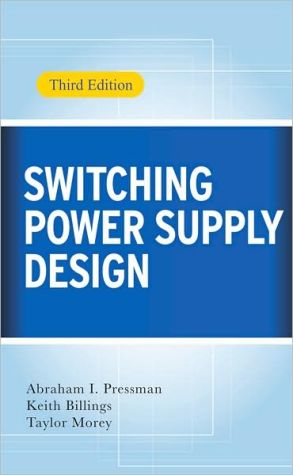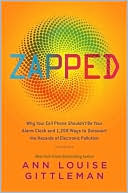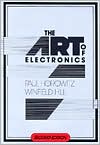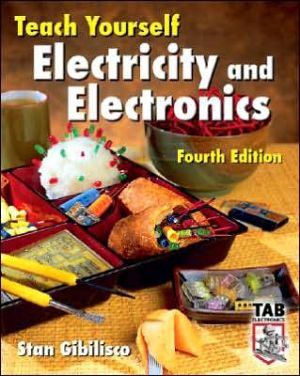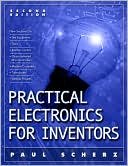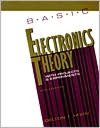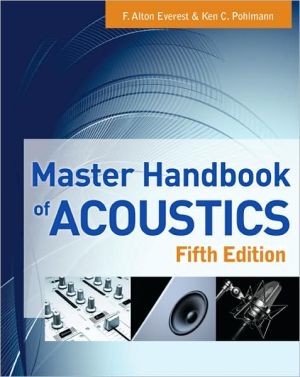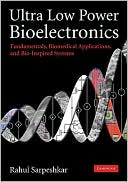Switching Power Supply Design, 3rd Ed.
The World's #1 Guide to Power Supply Design Now Updated!\ Recognized worldwide as the definitive guide to power supply design for over 25 years, Switching Power Supply Design has been updated to cover the latest innovations in technology, materials, and components. This Third Edition presents the basic principles of the most commonly used topologies, providing you with the essential information required to design cutting-edge power supplies. Using a tutorial, how-and-why approach, this expert...
Search in google:
A practical guide to state-of-the-art power supply design Nowhere else can you find, in one book, all the information you need to design a switching power supply. And no other book on the subject is as practical, yet mathematically sufficient, without being unnecessarily academic. Using a tutorial, how-to-do-it approach, Pressman first explains basic principles and why thigs are done as they are. With a knowledge of basic principles, the engineer can easily cope with new design requirements and evaluate alternative design decisions. The topics covered represent all those areas where a design decision has to be made in commencing a new design. These include: Topology Descriptions — A quantitative description of the roughly 15 commonly used topologies. Maximum current and voltage stress on power transistors for specified input voltage-output powers are described. The discussion permits selection of an optimum topology for the specified input-output voltages, output powers, and the selection of the power transistors; High-Frequency Magnetics Fundamentals—Ferrite core hysteresis, coil skin effect, and proximity effect losses; Transformer Design—Derivation of equation for transformer core selection for available output power as a function of frequency, flux density, iron and bobbin area, and topology; novel charts derived from the equations, permitting core selection at a glance; core, coil, total transformer loss, and temperature rise calculations; transformer design examples in major topologies; DC Current Biased Inductor Design — Design of inductors carrying DC bias currents using ferrite, MPP, Koolmu, and powered iron cores; Magnetic Amplifier, SnubberDesigns, and Resonant Converters; Feedbak Look Stabilization; Critical Polaroid Waveforms in Major Topologies. This second edition adds chapters on the current hottest topics in the field; power factor corrections, high-frequency ballsts for flourescent lamps, and low-input voltage power supplies for laptop computers. Booknews A guide to recent developments in the technology of power supply design, focusing on the current reliance on higher switching frequencies, which are possible because of power MOSFET transistors, newer topologies, and integrated-circuit pulse-width-modulating (PWM) chips. Emphasizes both circuit design and transformer design, with discussions of the magnetic design aspects; and reports on the merits and drawbacks, the usages and problem areas of the key topologies used in modern switching power supplies. Annotation c. Book News, Inc., Portland, OR (booknews.com)
Acknowledgments PrefacePart I: TopologiesChapter 1. Basic Topologies Chapter 2. Push-Pull and Forward Converter Topologies Chapter 3. Half- and Full-Bridge Converter Topologies Chapter 4. Flyback Converter Topologies Chapter 5. Current-Mode and Current-Fed Topologies Chapter 6. Miscellaneous TopologiesPart II: Magnetics and Circuit DesignChapter 7. Transformers and Magnetic Design Chapter 8. Bipolar Power Transistor Base Drive Circuits Chapter 9. MOSFET and IGBT Power Transistors and Gate Drive Requirements Chapter 10. Magnetic-Amplifier Postregulators Chapter 11. Analysis of Turn "On" and Turn "Off" Switching Losses and the Design of Load-Line Shaping Snubber Circuits Chapter 12. Feedback Loop Stabilization Chapter 13. Resonant ConvertersPart III: WaveformsChapter 14. Typical Waveforms for Switching Power SuppliesPart IV: More Recent Applications for Switching Power Supply TechniquesChapter 15. Power Factor and Power Factor Connection Chapter 16. Electronic Ballasts: High-Frequency Power Regulators for Fluorescent Lamps Chapter 17. Low-Input-Voltage Regulators for Laptop Computers and Portable ElectronicsAppendix Bibliography IndexAbraham Pressman was a nationally known power supply consultantwhose background ranged from army radar officer to four decades asan analog-digital design engineer.Keith Billings is a practicing engineer with morethan 40 years’ experience in the design of switching power equipment.Taylor MoreyTaylor Morey, currently a professor of Electronics at Conestoga College in Kitchener, Ontario, Canada, is co-author of an electronics devices textbook, and has taught courses at Wilfred Laurier University in Waterloo. He collaborates with Keith Billings as an independent power supply engineer and consultant, and previously worked in switchmode power supply development at Varian Canada in Georgetown, and Hammond Manufacturing and GFC Power in Guelph, where he first met Keith in 1988. During a 5-year sojourn to Mexico, he became fluent in Spanish and taught electronics engineering courses at the Universidad Católica de La Paz, and English as a second language at CIBNOR biological research institution of La Paz, where he also worked as an editor of graduate biology students’ articles for publication in refereed scientific journals. Earlier in his career he worked for IBM Canada on mainframe computers, and at Global TV’s studios in Toronto.
\ BooknewsThis definitive resource on designing a switching power supply uses a tutorial-style approach to explain basic principles and the reasons for various effects. The volume is divided into four main sections: topologies; magnetics and circuits designs; typical switching power supply waveforms; and newer applications. Magnetics design is emphasized, as the majority of power supply designers are primarily circuits-oriented. New chapters in this edition cover such new topics in the field as power factor correction, high-frequency ballasts for fluorescent lamps, and low-input voltage supplies for laptop computers. Annotation c. by Book News, Inc., Portland, Or.\ \ \ \ \ BooknewsA guide to recent developments in the technology of power supply design, focusing on the current reliance on higher switching frequencies, which are possible because of power MOSFET transistors, newer topologies, and integrated-circuit pulse-width-modulating (PWM) chips. Emphasizes both circuit design and transformer design, with discussions of the magnetic design aspects; and reports on the merits and drawbacks, the usages and problem areas of the key topologies used in modern switching power supplies. Annotation c. Book News, Inc., Portland, OR (booknews.com)\ \
